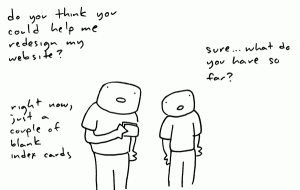A few years ago, I was running my first half marathon. About halfway through, I got a small rock in my shoe. I was having a great run and on pace to finish in under 2 hours (a lofty goal for my first half marathon) so I didn’t want to stop to get it out.
I kept running.
By mile 11 that small rock was really bothering me but I refused to stop. I had to hit my goal.
At mile 11.5, because I was favoring the foot with the rock, my running form was way off. Then it happened. I felt a pop and a searing pain my calf that forced me to stop running. Dang it! I was so close to the finish!!
I got that rock out of my shoe (finally) and, determined to finish, I started running again, in serious pain. I was running on my tip toes because that hurt less. I sprinted across the finish line in 1:48:06!
Then went immediately to the medical tent with the help of volunteers who had to carry me there.
Consequences of Not Stopping
When I saw this quote from Muhammad Ali it immediately reminded me of that run, and what I could have done differently. Sure, I still reached my goal of finishing in under two hours, but with serious consequence: an injury that sidelined me from running for 3 months. If you are a runner, you know how devastating this is.
While some might say “Push through it! It’s just a small pebble!” there are likely others who will say dealing with a small pain early on is easier than dealing with a lingering, larger one for months.
What would have happened if I had stopped when that rock first entered my shoe? Considering the pace I was running, it couldn’t have possibly affected my under 2 hours goal. In fact, stopping initially would have likely saved me the time that I stood on the side of the road while runners passed me by, debating if I would be able to finish or not. I could have (possibly) finished faster if I hadn’t pulled a muscle.
But I was too intent on the goal to realize how that small rock could have such a negative significant impact. Who would have thought it would lead to an injury that would last for months?
Pebbles in Business
Running a business is similar. You set a goal and start working toward it, but every once in a while, some ‘pebble’ interrupts your progress. You can stay focused on the goal and try to ignore the pebble, or stop and deal with it. Based on my running experience, it seems better to stop and deal. Fix or eliminate the problem so you can start climbing toward the goal again. Or maybe the disruption created a need for a new goal. In either case, evaluating and addressing your options at the point of interruption is more likely to make the climb a lot easier.









